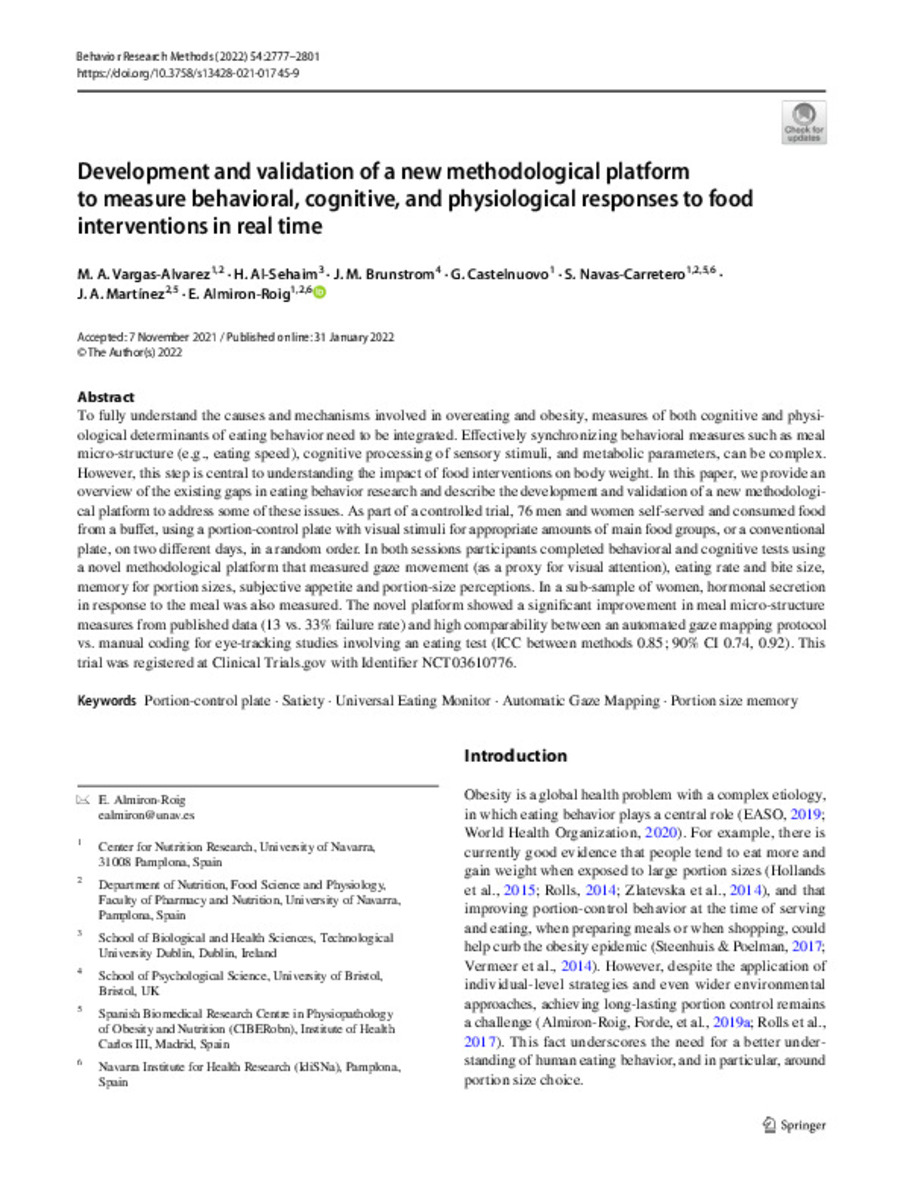Full metadata record
| DC Field | Value | Language |
|---|---|---|
| dc.creator | Vargas-Alvarez, M.A. (M.A.) | - |
| dc.creator | Al-Sehaim, H. (H.) | - |
| dc.creator | Brunstrom, J.M. (J.M.) | - |
| dc.creator | Castelnuovo, G. (Gabriele) | - |
| dc.creator | Navas-Carretero, S. (Santiago) | - |
| dc.creator | Martinez, J.A. (José Alfredo) | - |
| dc.creator | Almiron-Roig, E. (Eva) | - |
| dc.date.accessioned | 2023-05-03T10:38:41Z | - |
| dc.date.available | 2023-05-03T10:38:41Z | - |
| dc.date.issued | 2022 | - |
| dc.identifier.citation | Vargas-Alvarez, M.A. (M.A.); Al-Sehaim, H. (H.); Brunstrom, J.M. (J.M.); et al. "Development and validation of a new methodological platform to measure behavioral, cognitive, and physiological responses to food interventions in real time". Behavior Research Methods. 54, 2022, 2777 - 2801 | es_ES |
| dc.identifier.issn | 1554-3528 | - |
| dc.identifier.uri | https://hdl.handle.net/10171/66160 | - |
| dc.description.abstract | To fully understand the causes and mechanisms involved in overeating and obesity, measures of both cognitive and physiological determinants of eating behavior need to be integrated. Effectively synchronizing behavioral measures such as meal micro-structure (e.g., eating speed), cognitive processing of sensory stimuli, and metabolic parameters, can be complex. However, this step is central to understanding the impact of food interventions on body weight. In this paper, we provide an overview of the existing gaps in eating behavior research and describe the development and validation of a new methodological platform to address some of these issues. As part of a controlled trial, 76 men and women self-served and consumed food from a buffet, using a portion-control plate with visual stimuli for appropriate amounts of main food groups, or a conventional plate, on two different days, in a random order. In both sessions participants completed behavioral and cognitive tests using a novel methodological platform that measured gaze movement (as a proxy for visual attention), eating rate and bite size, memory for portion sizes, subjective appetite and portion-size perceptions. In a sub-sample of women, hormonal secretion in response to the meal was also measured. The novel platform showed a significant improvement in meal micro-structure measures from published data (13 vs. 33% failure rate) and high comparability between an automated gaze mapping protocol vs. manual coding for eye-tracking studies involving an eating test (ICC between methods 0.85; 90% CI 0.74, 0.92). This trial was registered at Clinical Trials.gov with Identifier NCT03610776. | es_ES |
| dc.description.sponsorship | Open Access funding provided thanks to the CRUE-CSIC agreement with Springer Nature. Financial support for this study was received from the Government of Navarra (PORTIONS Projects PT028 and PT008), the Centre for Nutrition Research, University of Navarra, and the Spanish Biomedical Research Centre in Physiopathology of Obesity and Nutrition (CIBERobn). Additional support in the form of portion-control tools and study foods was received for this study from Precise Portions LLC and from Herba Ricemills SLU, respectively | es_ES |
| dc.language.iso | eng | es_ES |
| dc.publisher | Springer | es_ES |
| dc.rights | info:eu-repo/semantics/openAccess | es_ES |
| dc.subject | Portion-control plate | es_ES |
| dc.subject | Satiety | es_ES |
| dc.subject | Universal Eating Monitor | es_ES |
| dc.subject | Automatic Gaze Mapping | es_ES |
| dc.subject | Portion size memory | es_ES |
| dc.title | Development and validation of a new methodological platform to measure behavioral, cognitive, and physiological responses to food interventions in real time | es_ES |
| dc.type | info:eu-repo/semantics/article | es_ES |
| dc.description.note | This article is licensed under a Creative Commons Attribution 4.0 International License | es_ES |
| dc.identifier.doi | 10.3758/s13428-021-01745-9 | - |
| dadun.citation.endingPage | 2801 | es_ES |
| dadun.citation.publicationName | Behavior Research Methods | es_ES |
| dadun.citation.startingPage | 2777 | es_ES |
| dadun.citation.volume | 54 | es_ES |
| dc.identifier.pmid | 35102518 | - |
Files in This Item:
Statistics and impact
Items in Dadun are protected by copyright, with all rights reserved, unless otherwise indicated.






